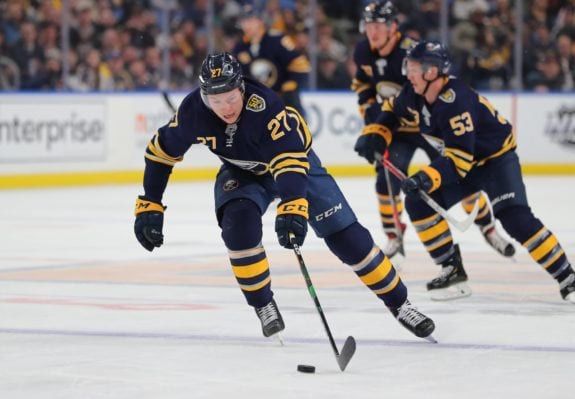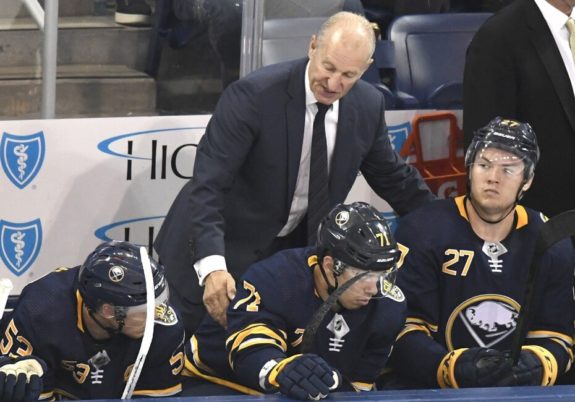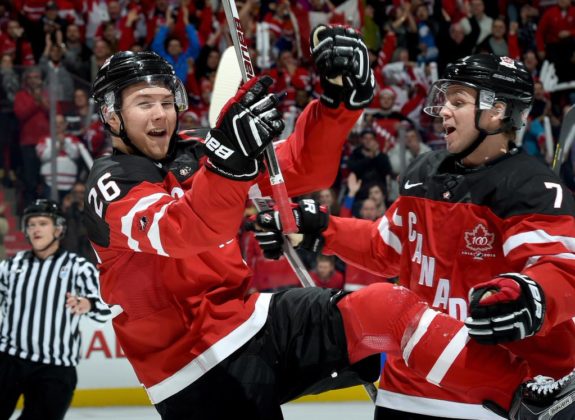He entered the organization with little fanfare.
When Curtis Lazar was signed on July 1 by the Buffalo Sabres, it was considered a move of little consequence. Lazar was tabbed by most to be nothing more than a depth signing for the American Hockey League’s Rochester Americans to help groom the next crop of Sabres’ hopefuls.
Lazar came to the Sabres organization having not been retained by the Calgary Flames. No doubt with a chip on his shoulder, he felt the need to impress his new bosses and send a message to his former team that they made a mistake.
Fast forward six and a half months and Lazar has cemented a role for himself with the big club. Once never considered a viable option, he has played in 17 contests, registering four goals and three assists. Due in part to injuries and his own production, he doesn’t look to be heading back to the Americans any time soon. What has been behind Lazar’s strong start?
Lazar Doing Much With Little
Lazar has seen himself in a depth role with the Sabres thus far, primarily seeing time with Jimmy Vesey and Zemgus Girgensons. Averaging just over 10 minutes per game, Lazar has certainly not seen prime deployment, yet he has been able to produce.
To date, Lazar has averaged 1.92 points for every hour on the ice at five-on-five. That ranks third on the team behind only Jack Eichel (2.28) and Sam Reinhart (2.19). Receiving top-line production rates from a bottom-six player on a league-minimum contract is a tremendous asset.
What’s interesting about Lazar is the way he’s gone about his production. Although putting up elite point rates, he ranks 23rd on the team in terms of shots per hour with 3.46 – dead last. He also ranks 23rd in shot attempts per hour with 6.54.

What has kept Lazar relevant on the scoresheet has been his ability to create quality chances over quantity. Firstly, he is the proud owner of a 22.22 percent shooting percentage. If that feels high, it’s probably because it is. Lazar is currently way out in first on the team, nearly seven percent ahead of his next closest teammate.
Logic would tell us that an extremely low-volume shooter with an extremely high shooting percentage is bound to regress in a big way. That could very well happen. What’s encouraging about these two extremes, however, is the regularity with which these shots are coming from high-quality scoring areas.
Lazar currently averages 0.6 expected goals (xG) for every hour he is on the ice at five-on-five according to Evolving-Hockey. That ranks sixth on the team, ahead of the likes of Reinhart and potential 30-goal man Victor Olofsson. This helps us appreciate a little bit more about how Lazar’s production is happening. It’s not as if he is getting a low volume of shots that are mostly from the outside of the zone. Rather, although he doesn’t put a ton of pucks toward the net, when he does, they are in situations where they are more apt to go in. While he could certainly see some regression in his totals, the way he goes about producing shouldn’t be impossible to continue to a reasonable degree.
Lazar’s Defence Making a Difference
Lazar’s impacts go beyond the scoresheet. He has also been a solid contributor on the defensive side of the puck. He has proven to be an elite shot-blocker, blocking 4.23 shots per hour at five-on-five. Shot-blocking is typically more of a skillset that is present in defencemen. Lazar, however, ranks first on the team in the rate of blocked shots, ahead of Colin Miller, Rasmus Ristolainen, Henri Jokiharju and Rasmus Dahlin. Having a forward that blocks more than a shot for every shot he takes is certainly a unique asset.
Lazar has also shown an ability to regain pucks that were lost to the opposition. Although he has had trouble with giving the puck away, he ranks eighth on the team in takeaways per hour. His tenacious and aggressive play has paid dividends in retaining possession of the puck.

Where Lazar’s aggressive play is most recognized is in the physical toll he exerts on opponents. When considering the most aggressive, physical players on the team, most would probably think of Ristolainen, Girgensons and Jake McCabe. Per hour, Lazar paces them by a country mile in hits. He averages 11.54 hits per hour- 2.65 more hits per hour than Ristolainen.
A final area where Lazar has shown an essential set of skills is his ability in the faceoff dot. The Sabres are last in the league in faceoff plus/minus at minus-233 on the season. Lazar has a strength in the dot, the only player currently on the roster who wins more than he loses.
Lazar a Great Value For Sabres
Granted, Lazar doesn’t spend nearly as much time on the ice as most of his teammates. If he was spending five to eight more minutes playing each game, no doubt some of these numbers would come back down closer to the rest of his team.
Lazar has seen a more extensive role for the Sabres’ penalty kill. While his impacts in that capacity have been less than stellar, the penalty kill has improved as a whole since the disastrous stretch at the beginning of the season. He is finding a niche here and it seems to be working. He has earned the trust of Ralph Krueger and is seeing the ice in crucial situations, including when he scored the empty-net goal against the Vegas Golden Knights to solidify the Sabres’ victory.
In any event, the Sabres appear to have done a nice piece of business in acquiring Lazar. Having not found a home with the Ottawa Senators or Flames, perhaps he has now found the right situation. The pedigree of being a first-round pick and playing for Team Canada at the World Junior Championship is not without any basis.

If the Sabres can continue to squeeze every ounce of production out of Lazar that they can, they will have gotten an excellent contract. Because his current deployment is quite low, he should prove inexpensive to re-sign if they decide to do so. What will be interesting to see is how Lazar reacts if given more responsibility in the lineup, whether it be due to injuries or Krueger looking to shake things up.
Lazar’s drive to prove the doubters wrong is pushing him back into a regular NHL job. The Sabres may have gotten an impactful player without the fanfare – and that’s long overdue.